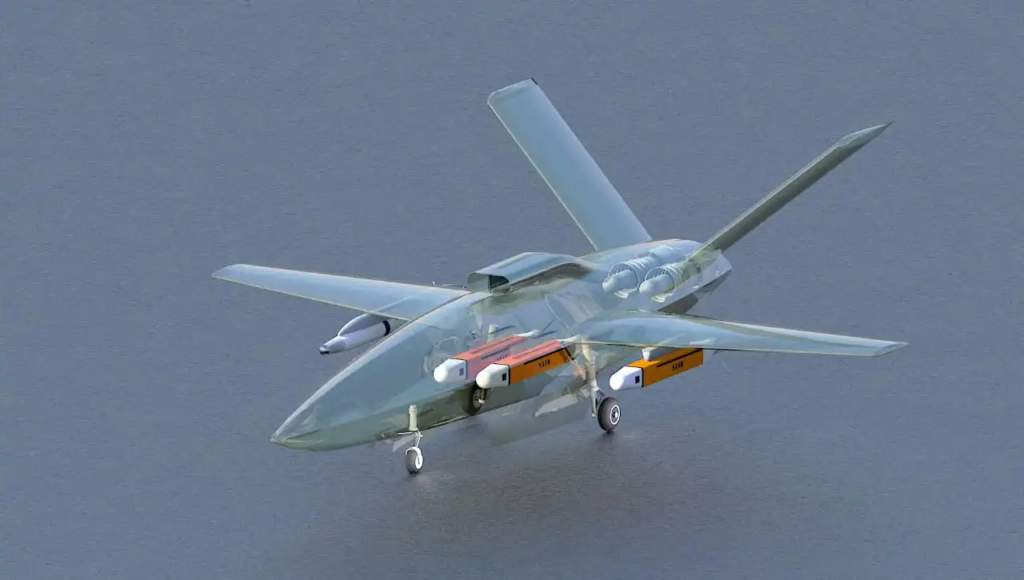The loyal wingman drones are autonomous military UCAVs, capable of sharing the mission load with the fighter aircraft. It can survive the battlefield at a lower cost than a manned fighter with similar capabilities. Hindustan Aeronautics Ltd (HAL) has announced that they will commence the flight trials of India’s first-ever loyal wingman ‘warrior drone’ by 2024.
A rendering of India’s Combat Air Teaming System (CATS) on the Hindustan Aeronautics Limited’s (HAL) website gives a significant insight into its design and internal layout, more than has been officially released at air shows and publicity material. The ‘loyal wingman’s’ two engines can be seen, with a more lethal loadout of air-to-ground and air-to-air missiles, if the new illustration is anything to go by.
HAL first unveiled the CATS at the 2021 Aero India exhibition in Bengaluru as a part of its manned-unmanned teaming (MUM-T) concept, with a mock-up of the ‘loyal wingman’ under a Tejas mock-up. That model showed a sizeable over-fuselage air intake, a Smart Anti-Airfield Weapon (SAAW) in the side internal bays, and an under-developed Next-Generation Close Combat Missile (NG-CCM). The last reports about the project quoted unnamed officials who announced the CATS flight testing to begin by 2024, it has completed the wind tunnel testing in March 2022. It has been said to have three components, namely the CATS Hunter, the CATS Warrior, and the Alpha-S, all of which are unmanned systems to be controlled from the mothership.

New CATS Warrior Wingman
The new rendering shows an over-fuselage air intake that juts out and does not blend in with the body of the rear fuselage, as shown in the mockups. The see-through image of the internal design shows three Defence Research Development Organization (DRDO)-developed SAAW.
Two of the SAAW are inside the wingman drone. But whether they are meant to be launched from its side internal bays or weapons bays on the underbelly – assuming the new design envisages the latter – is unknown. The mock-ups displayed so far showed the SAAW being placed in the side bays. The third SAAW is on the pylon under the left wing. The missile under the right-wing pylon is the NG-CCM, also seen in the early mockups of the drone when it was first unveiled.

The weapons loadout confirms the previously reported role of the CATS, which involves offensive ground strike capabilities and aerial engagement with other enemy fighter aircraft. The air-to-air combat role has not yet been envisioned for other under-development Collaborative Combat Aircraft (CCA) projects elsewhere in the world.
Selection of Power Plants – A Challenge
But it has retained the twin-engine layout, with two PTAE-7 jet engines developed by HAL near the exhaust. The PTAE-7 is a 400 kilogram, 3.43 kilonewton (kN) thrust, ‘single spool’ jet engine that HAL developed in the 1980s. Another jet engine option for the CATS is a 25 kN HTFE-25 turbofan under development by HAL, according to a March 2022 report on Janes.
“As the CATS Warrior is a twin-engine design, we believe that using two HTFE-25 engines will give the UCAV the necessary performance to match frontline combat aircraft,” the Janes report quoted a HAL source.
Therefore, the new rendering showing the PTAE-7 engines contradicts official claims. There can be one of two possibilities about the new rendering being at variance with mainstream media reports and official unveilings at exhibitions. One, the computer-generated (CG) image could be an earlier artwork before formal work on the CATS commenced. The project has been in the works since 2017. However, given the fact that HAL recently revamped its website, it raises the question of why it would release an image belonging to an earlier time.
The CATS wingman UCAV is shown alongside other missiles & drones—source X (formerly Twitter). Another possibility is that the design has to be frozen, and HAL is still undecided on the design configuration and the type of powerplant that would fly the plane. This, however, could not be independently verified in the absence of official word from HAL.

However, it is also unusual for a wingman to be powered by two engines, as all projects being tested and conceptualized until now, including the US XQ-58 Valkyrie, the French Dassault nEUROn that is to fly with the Rafale F5 fighters or the Russian S-70B Okhotnik which would be paired with the Su-57 Felon are all single-engine drones. Sourcing engines from any of the above-mentioned UCAV engine manufacturers can also be explored. However, matching the cruising speed with that of LCA of any other fighter jet is one of the QR of the wingman platform. The engine intake and exhaust are to be concealed to maintain the stealth characteristics of the wingman.
Title Image Courtesy: https://asmeiitr.medium.com/
Disclaimer: The views and opinions expressed by the author do not necessarily reflect the views of the Government of India and Defence Research and Studies
Article Courtesy: Eurasian Times






